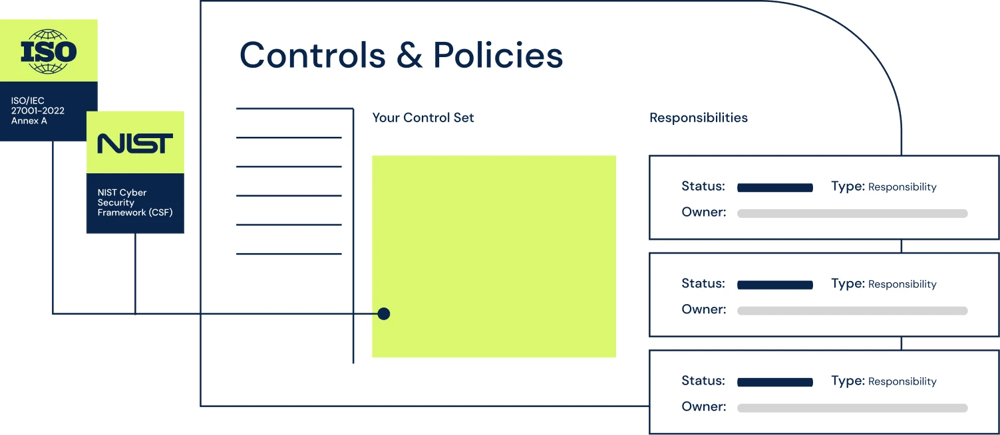The ISMS policy for ISO 27001 is a crucial document that outlines an organization's systematic approach to managing and protecting its information assets. By implementing appropriate security controls, the ISMS policy ensures the confidentiality, integrity, and availability of these valuable assets.
When considering the adoption of ISO 27001 and pursuing certification, it is important for organizations to weigh the costs and benefits. While implementing and maintaining an ISMS may require significant resources, the benefits can far outweigh the expenses. Having a comprehensive ISMS policy in place helps organizations identify and manage security risks, reduces the likelihood of security breaches, and enhances overall security management.
Achieving ISO 27001 certification demonstrates to stakeholders, clients, and partners that an organization has implemented best-practice guidelines for information security. It fosters a culture of continual improvement by requiring regular risk assessments, internal security audits, and compliance with applicable legal and contractual requirements. Furthermore, the structured approach provided by ISO 27001 ensures a holistic and structured approach to security, safeguarding both business-critical and proprietary information assets.
Explore the 6clicks solution for your ISMS supporting multiple standards and framworks. Or the solution for quick and easy ISO 27001 certification.
Definition of ISMS policy
An ISMS policy, or Information Security Management System policy, is a crucial component of organizations seeking to implement ISO 27001 and achieve certification. This policy serves as a guiding document that outlines the organization's commitment to information security and provides a framework for managing security risks and protecting valuable assets. It outlines the organization's approach to security management, including the systematic approach to risk assessment, the implementation of security controls, and the ongoing improvement of security measures. The ISMS policy sets the tone for the organization's security culture, reinforces the importance of security objectives, and ensures compliance with relevant legal and contractual requirements. In this article, we will explore the definition of an ISMS policy and the key elements that organizations should consider when developing and implementing their own.
Benefits of implementing an ISMS policy
Implementing an Information Security Management System (ISMS) policy offers several benefits to an organization. Firstly, it ensures the protection of sensitive information by establishing controls to safeguard against unauthorized access. This helps mitigate the risk of security breaches, preserving the confidentiality, integrity, and availability of critical data.
Secondly, an ISMS policy helps maintain business continuity by identifying potential risks and implementing measures to mitigate them. It ensures the organization is prepared for various security incidents and has a systematic approach to address them promptly, minimizing any potential disruptions.
Furthermore, implementing an ISMS policy helps organizations meet compliance requirements. It ensures adherence to industry-specific regulations and international security standards, such as ISO/IEC 27001. This demonstrates the organization's commitment to information security and can enhance its reputation among clients and stakeholders.
Another benefit is the verifiability of information security. An ISMS policy enables regular audits and assessments to evaluate the effectiveness of security controls. This provides confidence to both internal and external parties that the organization's information assets are adequately protected.
Finally, implementing an ISMS policy improves cost-effectiveness. By identifying and assessing security risks, organizations can allocate resources in a targeted manner. This ensures that investments in security measures are prioritized based on risk reduction and the protection of business-critical assets.
Importance of ISMS policy
An ISMS policy plays a crucial role in ensuring effective information security management and compliance within organizations. By outlining a structured and comprehensive approach to safeguarding sensitive data, an ISMS policy helps mitigate security risks and protect valuable assets.
One of the primary purposes of an ISMS policy is to identify and assess potential security risks. It provides a framework for conducting risk assessments to understand vulnerabilities and threats that may target an organization's information systems. This proactive approach enables organizations to implement appropriate security controls to minimize the likelihood and impact of security breaches.
Moreover, an ISMS policy helps organizations ensure compliance with laws, regulations, and industry standards. It sets forth guidelines and procedures that align with legal requirements, such as data protection regulations. By adhering to these guidelines, organizations can handle data responsibly, thus avoiding costly legal consequences and reputational damage.
Implementing an ISMS policy also brings efficiency and streamlined processes. It establishes clear roles and responsibilities for individuals responsible for information security management. This clarity promotes effective coordination among different stakeholders and enhances the overall efficiency of security-related activities. Furthermore, standardized procedures and guidelines enable a consistent approach to managing security incidents, saving valuable time and resources.
ISO 27001 guidelines to implement an ISMS policy
ISO 27001 provides guidelines for organizations to implement an Information Security Management System (ISMS) policy. This internationally recognized standard sets a framework for organizations to identify and assess potential security risks, ensuring compliance with laws, regulations, and industry standards. Implementing an ISMS policy brings efficiency and streamlined processes, establishing clear roles and responsibilities for individuals responsible for information security management. It promotes effective coordination and enhances the overall efficiency of security-related activities. Furthermore, standardized procedures and guidelines enable a consistent approach to managing security incidents, saving valuable time and resources. By adhering to ISO 27001 guidelines, organizations can proactively address security risks, protect their sensitive information, and maintain the trust of their stakeholders.
1. Establishing the ISMS policy
Establishing an Information Security Management System (ISMS) policy is a crucial step in protecting an organization's sensitive information and ensuring compliance with relevant laws and regulations. The ISMS policy sets the direction and objectives for managing information security effectively.
The process begins by aligning the ISMS policy with the organization's top management, ensuring their commitment and support. This involvement is essential to establish a framework that encompasses the organization's business objectives, risk appetite, and legal requirements.
Regular reviews and updates of the ISMS policy are equally important, as they allow for adjustments to meet changing security risks and compliance obligations. This systematic approach ensures ongoing effectiveness and continuous improvement.
The significance of the ISMS policy cannot be overstated. It mitigates security risks by prescribing security controls and measures to protect organizational assets, both physical and intellectual. Moreover, the policy provides a structured approach to identify, assess, and manage potential risks, reducing the likelihood of security breaches and unauthorized access.
Furthermore, the ISMS policy ensures compliance with applicable laws and regulations, such as ISO/IEC 27001, which is an international standard for information security management. It sets the level of security expected and demonstrates a commitment to safeguarding business-critical and proprietary information assets.
2. Performing a risk assessment
Performing a risk assessment is a critical component of implementing an Information Security Management System (ISMS) in accordance with ISO 27001. This process enables organizations to identify which assets require protection and the potential threats they are exposed to.
The first step in conducting a risk assessment is to identify the assets within the organization that need to be protected, such as data, systems, and physical resources. This step ensures that all relevant areas are considered during the assessment.
Next, vulnerabilities are assessed to determine the potential weaknesses that could be exploited by threats. This involves analyzing the organization's internal processes, controls, and technologies to identify potential weaknesses or gaps in security measures.
Once vulnerabilities are identified, the next step is to assess the potential impacts of these vulnerabilities being exploited. This involves considering the potential harm or consequences that could occur if the vulnerabilities were exploited, such as financial loss, reputational damage, or legal implications.
Finally, the risk levels are determined by combining the likelihood of threats occurring and the potential impacts of these threats. This allows organizations to prioritize their efforts and allocate resources effectively to mitigate the highest risks first.
By systematically conducting a risk assessment, organizations can identify and prioritize the most significant risks to their information security. This enables them to implement appropriate controls and measures to reduce the likelihood and impact of potential security incidents. Conforming to ISO 27001 guidelines ensures that organizations have a structured and effective approach to managing information security risks.
3. Developing and implementing controls
Once the risk assessment is completed, the next step in implementing an Information Security Management System (ISMS) policy is to develop and implement controls. Controls are designed to reduce the identified risks to an acceptable level, ensuring the protection of organizational assets.
The first aspect of developing controls is the creation of policies and procedures. Policies outline the high-level rules and guidelines that govern the organization's security practices, while procedures provide detailed instructions on how to implement these policies effectively. By developing clear policies and procedures, organizations establish a structured approach to security management.
Based on the results of the risk assessment, controls are designed to address the identified vulnerabilities and threats. These controls can include technical measures such as firewalls, encryption, and access controls, as well as organizational measures such as security awareness training and incident response procedures. The goal is to implement a combination of preventive, detective, and corrective controls to mitigate the identified risks.
Regular review and updating of these controls are crucial to maintain an effective ISMS. This is because the threat landscape is constantly evolving, and new risks may emerge over time. By regularly reviewing and updating controls, organizations ensure that they remain aligned with the current security risks and that their mitigation measures continue to be effective.
4. Monitoring and reviewing the ISMS
Monitoring and reviewing the Information Security Management System (ISMS) is essential in ensuring the proper functioning of an organization's security controls, as outlined in the ISO 27001 guidelines. A systematic approach to monitoring the ISMS allows organizations to proactively identify any deviations or potential vulnerabilities in their security practices.
Constant monitoring of the ISMS helps in identifying security risks and threats in real-time. By regularly reviewing security controls, organizations can detect any gaps or weaknesses and take appropriate action to address them. This ensures that the implemented controls remain effective in mitigating risks and protecting the organization's assets.
Periodic review of the ISMS also helps in ensuring its ongoing relevance and effectiveness. As the threat landscape evolves, new risks and vulnerabilities may emerge. By periodically reviewing the ISMS, organizations can identify and analyze these changes, allowing them to update and adapt their security controls accordingly.
The benefits of regularly monitoring and reviewing the ISMS go beyond just maintaining security. It allows organizations to achieve a continuous improvement cycle, where lessons learned from security incidents or breaches can be applied to enhance future controls. It also helps in ensuring compliance with applicable legal and contractual requirements, promoting trust and confidence among stakeholders.
What should you include in an ISMS policy?
An effective ISMS policy serves as the foundation for an organization's security management system. It outlines the purpose, roles and responsibilities, policy framework, and communication process necessary for maintaining a secure environment.
The purpose of the ISMS policy is to provide a clear statement of the organization's commitment to information security. It should define the objectives and scope of the ISMS, ensuring alignment with the organization's overall goals and strategies.
Roles and responsibilities should be clearly defined within the policy. This includes identifying key individuals responsible for implementing, managing, and maintaining the ISMS, as well as their specific duties and authorities.
The policy framework outlines the structure of the ISMS and the approach that will be taken to establish and maintain security controls. It should include a risk management process for identifying and assessing security risks, as well as a plan for implementing appropriate security controls to mitigate these risks.
Effective communication is crucial in ensuring the understanding and adherence to the ISMS policy. The policy should specify how information regarding security risks, controls, and compliance requirements will be communicated to relevant stakeholders. It should also outline the process for reporting security incidents and breaches and the measures that will be taken to address them.
Addressing security risks is a fundamental aspect of an ISMS policy. It should emphasize the need for regular risk assessments to identify and evaluate potential threats, vulnerabilities, and impacts. The policy should also outline the procedures and controls that will be implemented to manage and mitigate these risks.
Compliance with applicable laws, regulations, and industry standards is another key element of an ISMS policy. It should clearly state the commitment to adhere to legal and contractual requirements regarding information security. This includes outlining the process for conducting internal audits to ensure conformity and the actions that will be taken in the event of non-compliance.
Check out the 6clicks content library for policies, control sets, standards and frameworks for your ISMS.
What is covered under ISO 27001 Clause 5.2?
ISO/IEC 27001 Clause 5.2 outlines the requirements for the information security policy and the additional actions that must be taken by top management. The information security policy serves as the foundation of the Information Security Management System (ISMS) and sets the direction and objectives for information security within the organization.
The policy must be relevant and aligned with the organization's overall goals, strategies, and context. It must be communicated to all employees and stakeholders to ensure a shared understanding of the importance of information security.
Top management has a crucial role in ensuring the policy's implementation and effectiveness. They need to provide leadership, commitment, and resources to establish and maintain the ISMS. Additionally, top management must promote a culture of information security throughout the organization, encouraging all employees to take responsibility for the security of organizational assets.
Evidence of implementation is essential to demonstrate that the ISMS is operating effectively. This can be achieved through the documentation of processes, procedures, and controls that are put in place to support the policy. Regular audits, reviews, and management reviews are also necessary to evaluate the performance of the ISMS and identify areas for improvement.
Written by Andrew Robinson
Andrew started his career in the startup world and went on to perform in cyber and information security advisory roles for the Australian Federal Government and several Victorian Government entities. Andrew has a Masters in Policing, Intelligence and Counter-Terrorism (PICT) specialising in Cyber Security and holds IRAP, ISO 27001 LA, CISSP, CISM and SCF certifications.












